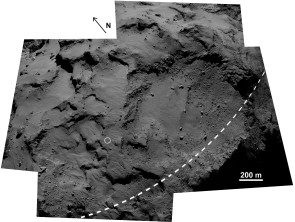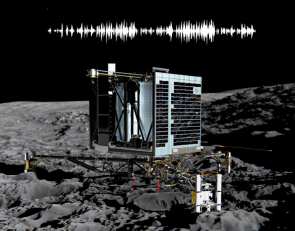Rosetta and Philae: one year since landing on a comet
12 November 2015
One year since Philae made its historic landing on a comet, mission teams remain hopeful for renewed contact with the lander, while also looking ahead to next year's grand finale: making a controlled impact of the Rosetta orbiter on the comet.| Reconstructing Philae's flight. (Click here for further details and larger versions of this video.) |
Rosetta arrived at Comet 67P/Churyumov-Gerasimenko on 6 August 2014, and after an initial survey and selection of a landing site, Philae was delivered to the surface on 12 November.
After touching down in the Agilkia region as planned, Philae did not secure itself to the comet, and it bounced to a new location in Abydos. Its flight across the surface is depicted in a new animation, using data collected by Rosetta and Philae to reconstruct the lander's rotation and attitude.
In the year since landing, a thorough analysis has also now been performed on why Philae bounced.
There were three methods to secure it after landing: ice screws, harpoons and a small thruster. The ice screws were designed with relatively soft material in mind, but Agilkia turned out to be very hard and they did not penetrate the surface.
The harpoons were capable of working in both softer and harder material. They were supposed to fire on contact and lock Philae to the surface, while a thruster on top of the lander was meant to push it down to counteract the recoil from the harpoon.
Attempts to arm the thruster the night before failed: it is thought that a seal did not open, although a sensor failure cannot be excluded.
 |
| Agilkia mosaic. Credit: ESA/Rosetta/MPS for OSIRIS Team MPS/UPD/LAM/IAA/SSO/INTA/UPM/DASP/IDA |
Then, on landing, the harpoons themselves did not fire. "It seems that the problem was either with the four 'bridge wires' taking current to ignite the explosive that triggers the harpoons, or the explosive itself, which may have degraded over time," explains Stephan Ulamec, Philae lander manager at the DLR German Aerospace Center.
"In any case, if we can regain contact with Philae, we might consider an attempt to retry the firing."
The reason is scientific: the harpoons contain sensors that could measure the temperature below the surface.
Despite the unplanned bouncing, Philae completed 80% of its planned first science sequence before falling into hibernation in the early hours of 15 November when the primary battery was exhausted. There was not enough sunlight in Philae's final location at Abydos to charge the secondary batteries and continue science measurements.
The hope was that as the comet moved nearer to the Sun, heading towards closest approach in August, there would be enough energy to reactivate Philae. Indeed, contact was made with the lander on 13 June but only eight intermittent contacts were made up to 9 July.
The problem was that the increasing sunlight also led to increased activity on the comet, forcing Rosetta to retreat to several hundred kilometres for safety, well out of range with Philae.
 |
| The sound of Philae hammering. Click image for details and sound files. Credit: ESA/ Rosetta/Philae/SESAME/DLR (CC BY-SA IGO 3.0) |
However, over the past few weeks, with the comet's activity now subsiding, Rosetta has started to approach again. This week it reached 200 km, the limit for making good contact with Philae, and today it dips to within 170 km.
In the meantime, the lander teams have continued their analysis of the data returned during the contacts in June and July, hoping to understand the status of Philae when it first woke up from hibernation.
"We had already determined that one of Philae's two receivers and one of the two transmitters were likely no longer working," says Koen Geurts, Philae's technical manager at DLR's Lander Control Centre in Cologne, Germany, "and it now seems that the other transmitter is suffering problems. Sometimes it did not switch on as expected, or it switched off too early, meaning that we likely missed possible contacts."
The team is taking this new information into account to determine the most promising strategy to regain regular contact.
But it's a race against time: with the comet now heading out beyond the orbit of Mars, temperatures are falling.
"We think we have until the end of January before the lander's internal temperature gets too cold to operate: it cannot work below -51°C," adds Koen.
| Philae's descent: the director's cut. (Click here for further details and larger versions of this video.) |
Meanwhile, Rosetta continues to return unique data with its suite of instruments, analysing changes to the comet's surface, atmosphere and plasma environment in incredible detail.
"We recently celebrated our first year at the comet and we are looking forward to the scientific discoveries the next year will bring," says Matt Taylor, ESA's Rosetta project scientist.
"Next year, we plan to do another far excursion, this time through the comet's tail and out to 2000 km. To complement that, we hope to make some very close flybys towards the end of the mission, as we prepare to put the orbiter down on the comet."
The plan is to end the mission with a 'controlled impact' of Rosetta on the surface. This idea emerged around six months ago, when an extension of operations from December 2015 to September 2016 was announced.
The solar-powered Rosetta will no longer receive enough sunlight to operate as the comet recedes from the Sun, out beyond the orbit of Jupiter on its 6.5-year circuit. It will travel even further out than during the previous 31 months of deep-space hibernation that ended in January 2014.
In addition, as seen from Earth next September, Rosetta and the comet will look very close to the Sun, making the relay of both scientific data and operational commands very difficult.
The Rosetta teams are now investigating the manoeuvres needed for operating close to the comet in the weeks leading up to the dramatic mission finale.
"We are still discussing exactly what the final end of mission scenario will involve," says Sylvain Lodiot, ESA's Rosetta spacecraft operations manager. "It is very complex and challenging, even more so even than the lander delivery trajectory our flight dynamics teams had to plan for delivering Philae.
"The schedule we're looking at would first involve a move into highly elliptical orbits – perhaps as low as 1 km – in August, before moving out to a more distant point for a final approach that will set Rosetta on a slow collision course with the comet at the end of September."
It is expected that science observations would continue throughout and up to almost the end of mission, allowing Rosetta's instruments to gather unique data at unprecedentedly close distances.
"We'll control Rosetta all the way down to the end, but once on the surface it will be highly improbable that we'll be able to 'speak' to it anymore," adds Sylvain.
"Landing Rosetta on a comet will be a fitting ending to this incredible mission," says Patrick Martin, ESA's Rosetta mission manager.
Further information
Background information regarding landing Rosetta on the comet: From one comet landing to another: planning Rosetta's grand finale
More about the new animation: Reconstructing Philae's flight across the comet
More about the SESAME-CASSE experiment that 'listened' to MUPUS hammer the surface of the comet: The sound of Philae conducting science
About Rosetta
Rosetta is an ESA mission with contributions from its Member States and NASA. Rosetta's Philae lander was provided by a consortium led by DLR, MPS, CNES and ASI.
For further information, please contact:
Markus Bauer
ESA Science and Robotic Exploration Communication Officer
Tel: +31 71 565 6799
Mob: +31 61 594 3 954
Email: markus.bauer![]() esa.int
esa.int
Patrick Martin
Rosetta Mission Manager
Email: patrick.martin![]() esa.int
esa.int
Sylvain Lodiot
Rosetta Spacecraft Operations Manager
Email: sylvain.lodiot![]() esa.int
esa.int
Matt Taylor
ESA Rosetta Project Scientist
Email: matt.taylor![]() esa.int
esa.int
Koen Geurts
Philae Lander Technical Manager, DLR
Email: Koen.Geurts![]() dlr.de
dlr.de
Stephan Ulamec
Philae Lander Manager, DLR
Email: Stephan.Ulamec![]() dlr.de
dlr.de




